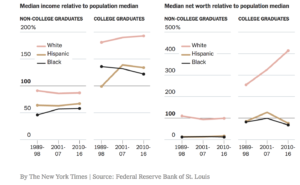(Editor Note: Insight Bytes focus on key economic issues and solutions for all of us, on Thursdays we spotlight in more depth Solutions to issues we have identified. Fridays we focus on how to build the Common Good. Please right click on images to see them larger in a separate tab. Click on the Index Topic Name at the beginning of each post to see more posts on that topic on PC or Laptop.)

Photo: thedailybeast.com
As the stock market continues to defy gravity and news stories herald the second longest economic recovery since WWII, yet many working class people are left out of the recovery. A recent report by the St. Louis Federal Reserve shows that non college graduates have lost ground or are just maintaining their economic status since 1998.

Sources: The New York Times, Federal Reserve Bank of St. Louis – 9/14/18
College graduates continue to make strides in income and dramatically increased wealth versus the median since 1989. Though college graduates who were Black or Hispanic actually saw a decline in their wealth levels versus the median. However, non-graduate whites while gaining some income versus the median saw their income largely stagnant and wealth accumulation flat. Non graduate Hispanics and Blacks fared even worse than whites in the case of blacks making zero progress over the median in wealth and half the progress of whites in income over the last 30 years.
William R. Emmons, an economist at the St. Louis Fed and a co-author of its report, noted in a New York Times story, ‘the most striking result was the steep declines among white families headed by someone without a college degree. Members of this group — labeled the white working class — not only were left behind financially, but also lagged in other measures of well-being, like self-reported health, homeownership, and marriage or cohabitation rates.’
Next steps:
We have noted in posts the urgent need for a comprehensive ‘Marshall Plan’ like imitative in our nation’s Heartland. Unemployment is two to three times higher there, high quality education is not as accessible, the opioid epidemic is gripping major sections of the Midwest and rural South while there is a failing infrastructure with slow Internet speeds. All this lack of investment leaves our Heartland citizens out of the economic and career opportunities that other regions have enjoyed since the Great Recession. We recommend that the federal government provide seed funding, borrowing from the successful Silicon Valley mode of venture investment, for partnerships between universities and colleges to develop innovation centers for job training, health services, enhanced apprenticeship programs, startup incubators and installation of high speed internet fiber optic systems. There is no time to waste, this initiative needs to be implemented immediately to prevent even further widening of the economic gap between coastal regions and our Heartland.
